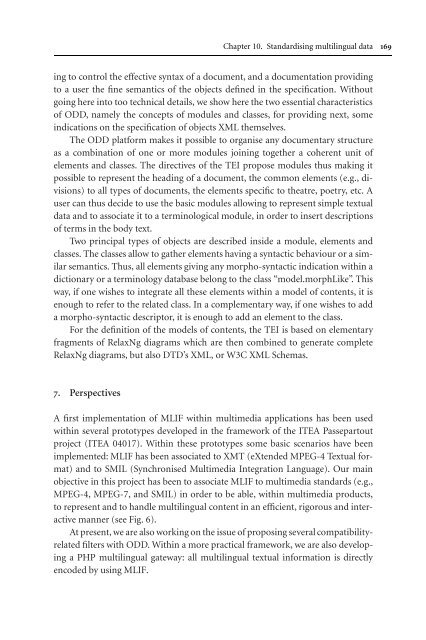Topics in Language Resources for Translation ... - ymerleksi - home
Topics in Language Resources for Translation ... - ymerleksi - home
Topics in Language Resources for Translation ... - ymerleksi - home
- No tags were found...
You also want an ePaper? Increase the reach of your titles
YUMPU automatically turns print PDFs into web optimized ePapers that Google loves.
Chapter 10. Standardis<strong>in</strong>g multil<strong>in</strong>gual data 169<strong>in</strong>g to control the effective syntax of a document, and a documentation provid<strong>in</strong>gto a user the f<strong>in</strong>e semantics of the objects def<strong>in</strong>ed <strong>in</strong> the specification. Withoutgo<strong>in</strong>g here <strong>in</strong>to too technical details, we show here the two essential characteristicsof ODD, namely the concepts of modules and classes, <strong>for</strong> provid<strong>in</strong>g next, some<strong>in</strong>dications on the specification of objects XML themselves.TheODDplat<strong>for</strong>mmakesitpossibletoorganiseanydocumentarystructureas a comb<strong>in</strong>ation of one or more modules jo<strong>in</strong><strong>in</strong>g together a coherent unit ofelements and classes. The directives of the TEI propose modules thus mak<strong>in</strong>g itpossible to represent the head<strong>in</strong>g of a document, the common elements (e.g., divisions)to all types of documents, the elements specific to theatre, poetry, etc. Auser can thus decide to use the basic modules allow<strong>in</strong>g to represent simple textualdata and to associate it to a term<strong>in</strong>ological module, <strong>in</strong> order to <strong>in</strong>sert descriptionsof terms <strong>in</strong> the body text.Two pr<strong>in</strong>cipal types of objects are described <strong>in</strong>side a module, elements andclasses. The classes allow to gather elements hav<strong>in</strong>g a syntactic behaviour or a similarsemantics. Thus, all elements giv<strong>in</strong>g any morpho-syntactic <strong>in</strong>dication with<strong>in</strong> adictionary or a term<strong>in</strong>ology database belong to the class “model.morphLike”. Thisway, if one wishes to <strong>in</strong>tegrate all these elements with<strong>in</strong> a model of contents, it isenough to refer to the related class. In a complementary way, if one wishes to adda morpho-syntactic descriptor, it is enough to add an element to the class.For the def<strong>in</strong>ition of the models of contents, the TEI is based on elementaryfragments of RelaxNg diagrams which are then comb<strong>in</strong>ed to generate completeRelaxNg diagrams, but also DTD’s XML, or W3C XML Schemas.7. PerspectivesA first implementation of MLIF with<strong>in</strong> multimedia applications has been usedwith<strong>in</strong> several prototypes developed <strong>in</strong> the framework of the ITEA Passepartoutproject (ITEA 04017). With<strong>in</strong> these prototypes some basic scenarios have beenimplemented: MLIF has been associated to XMT (eXtended MPEG-4 Textual <strong>for</strong>mat)and to SMIL (Synchronised Multimedia Integration <strong>Language</strong>). Our ma<strong>in</strong>objective <strong>in</strong> this project has been to associate MLIF to multimedia standards (e.g.,MPEG-4, MPEG-7, and SMIL) <strong>in</strong> order to be able, with<strong>in</strong> multimedia products,to represent and to handle multil<strong>in</strong>gual content <strong>in</strong> an efficient, rigorous and <strong>in</strong>teractivemanner (see Fig. 6).At present, we are also work<strong>in</strong>g on the issue of propos<strong>in</strong>g several compatibilityrelatedfilters with ODD. With<strong>in</strong> a more practical framework, we are also develop<strong>in</strong>ga PHP multil<strong>in</strong>gual gateway: all multil<strong>in</strong>gual textual <strong>in</strong><strong>for</strong>mation is directlyencoded by us<strong>in</strong>g MLIF.
















